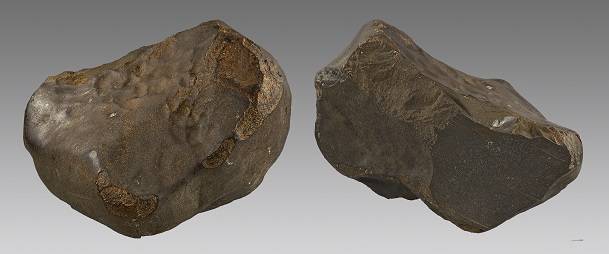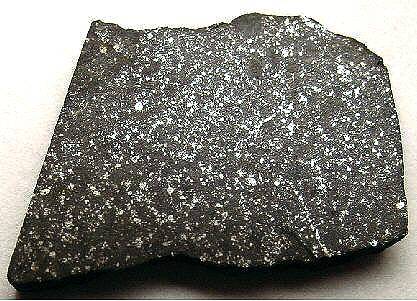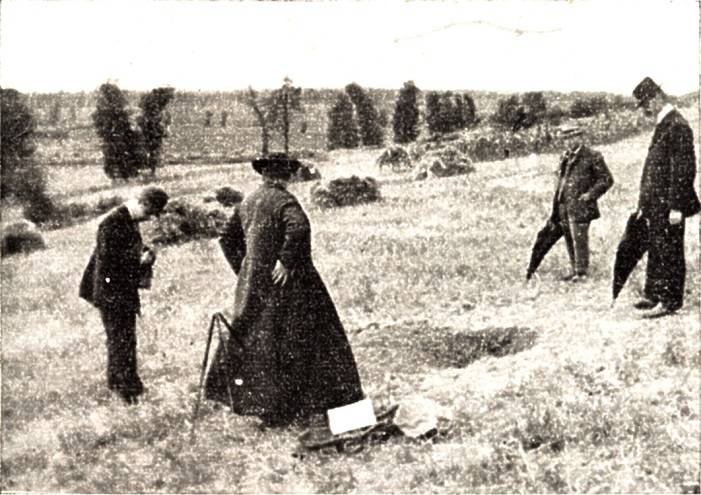Saint Sauveur
EH5
Impact-melt brecciaWork in Progress ... A rock that is a mechanical mixture of different minerals and/or rock fragments (clasts). A breccia may also be distinguished by the origin of its clasts: (monomict breccia: monogenetic or monolithologic, and polymict breccia: polygenetic or polylithologic). The proportions of these fragments within the unbrecciated material Click on Term to Read More
(EHb5 in Weyrauch et al., 2018)
Fell July 10, 1914
43° 44′ N., 1° 23′ E. Around 2:00 on a July afternoon, people in Haute Garonne, France heard detonations and observed the fallMeteorite seen to fall. Such meteorites are usually collected soon after falling and are not affected by terrestrial weathering (Weathering = 0). Beginning in 2014 (date needs confirmation), the NomComm adopted the use of the terms "probable fall" and "confirmed fall" to provide better insight into the meteorite's history. If Click on Term to Read More of a meteorHow long Sonic booms Of the several 10s of tons of cosmic material entering Earth's atmosphere each day, only about one ton reaches the surface. An object's chance of survival depends on its initial mass, speed and angle of entry, and friability (tendency to break up). Micrometeoroids radiate heat so Click on Term to Read More. A meteoriteWork in progress. A solid natural object reaching a planet’s surface from interplanetary space. Solid portion of a meteoroid that survives its fall to Earth, or some other body. Meteorites are classified as stony meteorites, iron meteorites, and stony-iron meteorites. These groups are further divided according to their mineralogy and Click on Term to Read More weighing ~14 kg was recovered 1.5 km south of Saint-Sauveur. The owner of the field in which it fell, Antoine Esculie, donated the stone free of charge to the Museum of Toulouse (R. Mathieu).
Photo courtesy of Société d’Histoire Naturelle de Toulouse
Originally published in the Bulletin de la Société d’Histoire Naturelle de Toulouse, vol. 93 (1958), by G. Astre.
Pictured L–R: Gaston Astre, geologist and naturalist, director of the Museum of Toulouse (1944–1962); Guillaume Champagne, priest of Saint-Sauveur; unidentified neighbor; Barthélémy Cazemajou, mayor of Saint-Sauveur Saint-Sauveur is a member of the high-Fe group of enstatiteA mineral that is composed of Mg-rich pyroxene, MgSiO3. It is the magnesium endmember of the pyroxene silicate mineral series - enstatite (MgSiO3) to ferrosilite (FeSiO3). Click on Term to Read More chondritesChondrites are the most common meteorites accounting for ~84% of falls. Chondrites are comprised mostly of Fe- and Mg-bearing silicate minerals (found in both chondrules and fine grained matrix), reduced Fe/Ni metal (found in various states like large blebs, small grains and/or even chondrule rims), and various refractory inclusions (such Click on Term to Read More, one of a very small number classified as petrologic typeMeasure of the degree of aqueous alteration (Types 1 and 2) and thermal metamorphism (Types 3-6) experienced by a chondritic meteorite. Type 3 chondrites are further subdivided into 3.0 through 3.9 subtypes. 5. It is considered to be an impact-melt breccia, and has been weakly shock metamorphosed to stage S3 corresponding to a shock pressure of ~10 GPa. Shock features include planar fractures and twinned clinoenstatite lamellae within orthopyroxeneOrthorhombic, low-Ca pyroxene common in chondrites. Its compositional range runs from all Mg-rich enstatite, MgSiO3 to Fe-rich ferrosilite, FeSiO3. These end-members form an almost complete solid solution where Mg2+ substitutes for Fe2+ up to about 90 mol. % and Ca substitutes no more than ~5 mol. % (higher Ca2+ contents occur Click on Term to Read More, and the occurrence of opaque veins of kamaciteMore common than taenite, both taenite and kamacite are Ni-Fe alloys found in iron meteorites. Kamacite, α-(Fe,Ni), contains 4-7.5 wt% Ni, and forms large body-centered cubic crystals that appear like broad bands or beam-like structures on the etched surface of a meteorite; its name is derived from the Greek word Click on Term to Read More and troiliteBrass colored non-magnetic mineral of iron sulfide, FeS, found in a variety of meteorites. Click on Term to Read More.
| ENSTATITE CHONDRITEType of meteorite high in the mineral enstatite and also referred to as E-chondrites. Although they contain substantial amounts of Fe, it is in the form of Ni-Fe metal or sulfide rather than as oxides in silicates. Their highly reduced nature indicates that they formed in an area of the Click on Term to Read More SUBGROUPS Weyrauch et al., 2018 |
||||
|---|---|---|---|---|
| EHa | EHb | ELa | ELb | |
| Troilite | Cr <2 wt% | Cr >2 wt% | Cr <2 wt% | Cr >2 wt% |
| (Mn,Mg,Fe)S | Fe <20 wt% | Fe >20 wt% | Fe <20 wt% | Fe >20 wt% |
| Daubréelite | Abundant | Missing | Abundant | Missing |
| Kamacite | Ni <6.5 wt% | Ni >6.5 wt% | Ni <6.5 wt% | Ni >6.5 wt% |
A few other E chondrites with intermediate mineralogy have also been identified, including LAP 031220 (EH4), QUE 94204 (EH7), Y-793225 (E-an), LEW 87223 (E-an), and PCA 91020 (possibly related to LEW 87223). Studies have determined that these meteorites were not derived from the EH or EL source through any metamorphic processes, and some or all of them could represent separate E chondrite asteroids. The revised E chondrite classification scheme of Weyrauch et al. (2018) including selected examples from their 80-sample study can be found here. It was determined that Saint-Sauveur is a member of the EHb subgroup.
Enstatite chondrites have O-isotope compositions that plot along the terrestrial fractionation line, suggesting that they may have formed within the Mercury–Venus region in the inner Solar SystemThe Sun and set of objects orbiting around it including planets and their moons and rings, asteroids, comets, and meteoroids., and that they were subsequently perturbed into the inner regions of the asteroid beltBelt located between 2.12 and 3.3 AU from the Sun and located between the orbits of Mars and Jupiter containing the vast majority of asteroids. The asteroid belt is also termed the main asteroid belt or main belt to distinguish it from other asteroid populations in the Solar System such Click on Term to Read More. In such a case, the strongly reducingOxidation and reduction together are called redox (reduction and oxidation) and generally characterized by the transfer of electrons between chemical species, like molecules, atoms or ions, where one species undergoes oxidation, a loss of electrons, while another species undergoes reduction, a gain of electrons. This transfer of electrons between reactants Click on Term to Read More conditions under which they were formed could have been promoted by an excess of H and C, maintained by a hot, dusty environment close to the Sun. Utilizing Mn–Cr isotopeOne of two or more atoms with the same atomic number (Z), but different mass (A). For example, hydrogen has three isotopes: 1H, 2H (deuterium), and 3H (tritium). Different isotopes of a given element have different numbers of neutrons in the nucleus. Click on Term to Read More systematics, Shukolyukov and Lugmair (2004) concluded that the E chondrites formed at a location closer to the Sun—between at least 1 AUThe astronomical unit for length is described as the "mean" distance (average of aphelion and perihelion distances) between the Earth and the Sun. Though most references state the value for 1 AU to be approximately 150 million kilometers, the currently accepted precise value for the AU is 149,597,870.66 km. The Click on Term to Read More outward to 1.4 AU—than at the location within the asteroid belt they now occupy. However, if the region between ~1.0 and 1.4 AU were truly the formation location of E chondrites, they should have highly elliptical orbits; but this is not what is observed. In fact, reflectance spectrometry has identified asteroids similar to E chondrites in stable orbits between 1.8 and 3.2 AU, suggesting that the inner asteroid belt is the actual location where they originated. In addition, a heliocentricCentered around a sun. Our own Solar System is centered around the Sun so that all planets such as Earth orbit around the Sun. Note that 25% of Americans incorrectly believe the Sun revolves around the Earth. Click on Term to Read More distance of ~2.0–2.9 AU was calculated for two E chondrites on the basis of their implanted solar noble gasElement occurring in the right-most column of the periodic table; also called "inert" gases. In these gases, the outer electron shell is completely filled, making them very unreactive. Click on Term to Read More concentrations (Nakashima et al., 2004). Furthermore, an isotopically anomalous Xe-containing component, associated with an anomalous light N component, is found proportionately in both carbonaceous and enstatite chondrites, but not on Earth. Since this component is almost certainly of nucleosynthetic origin, it follows that the carbonaceous and enstatite chondrites should share a similar heliocentric formation location. In this case, the strongly reducing conditions under which E chondrites formed could have been promoted by the loss of refractory oxides prior to condensation from the local nebulaAn immense interstellar, diffuse cloud of gas and dust from which a central star and surrounding planets and planetesimals condense and accrete. The properties of nebulae vary enormously and depend on their composition as well as the environment in which they are situated. Emission nebula are powered by young, massive Click on Term to Read More. Data from Rb–Sr systematics infer a formation age for Saint-Sauveur of 4.516 (±0.029) b.y., with indications of a high-temperature shock event occurring 60–200 m.y. after formation, consistent with the presence of the high-pressure silicaSilicon dioxide, SiO2. polymorph cristobaliteHigh temperature polymorph of silicon dioxide (SiO2). Has the same chemical composition as coesite, stishovite, seifertite and tridymite but possesses a different crystal structure. This silica group mineral occurs in terrestrial volcanic rocks, martian and lunar meteorites, chondrites and impact glasses like Libyan Desert Glass. Cristobalite has a very open Click on Term to Read More. This cristobalite was preserved through rapid cooling (Kimura et al., 2005). The occurrence in Saint-Sauveur of the mineral keilite, produced from melting of niningerite and troilite, is also indicative of an impact melting event accompanied by rapid quenching (Hill et al., 2014). The presence of fluor-richterite grains also attests to an impact-melt history. Cosmic-ray exposure ages are generally lower for EH chondrites than for EL chondrites, 0.5–7 m.y. and 4–18 m.y., respectively. More in-depth information on the complex thermal history of the EH chondrites can be found on the Sahara 97096 page. A xenolithFragment of a rock or meteorite that formed apart from the host material. Click on Term to Read More that was found in the carbonaceous chondriteCarbonaceous chondrites represent the most primitive rock samples of our solar system. This rare (less than 5% of all meteorite falls) class of meteorites are a time capsule from the earliest days in the formation of our solar system. They are divided into the following compositional groups that, other than Click on Term to Read More Kaidun, named Kaidun III, has been determined to be an EH5 inclusion, one that underwent hydrationReaction of a substance with water. Click on Term to Read More on the Kaidun parent bodyThe body from which a meteorite or meteoroid was derived prior to its ejection. Some parent bodies were destroyed early in the formation of our Solar System, while others like the asteroid 4-Vesta and Mars are still observable today. Click on Term to Read More. Interestingly, another clastA mineral or rock fragment embedded in another rock. Click on Term to Read More found in a Kaidun sample is a rare EL3, named Kaidun IV. In addition to three Antarctic EH5 members, the St. Mark’s meteorite is the only other non-Antarctic EH5 sample in our collections. The specimen of Saint-Sauveur shown above is a 1.34 g partial slice obtained in a trade with the Muséum National d’Histoire Naturelle, Paris, France, by International Meteorite Brokerage. The photo below is the 14 kg main massLargest fragment of a meteorite, typically at the time of recovery. Meteorites are commonly cut, sliced or sometimes broken thus reducing the size of the main mass and the resulting largest specimen is called the "largest known mass". Click on Term to Read More of Saint-Sauveur in the Muséum de Toulouse.
click on photo for a magnified view
Photo courtesy of Didier Descouens—Muséum de Toulouse








